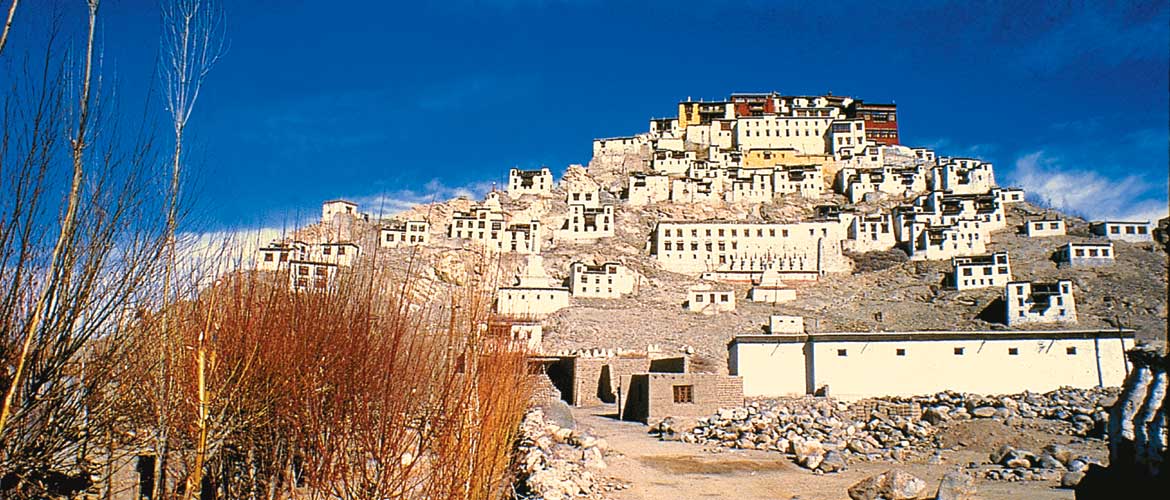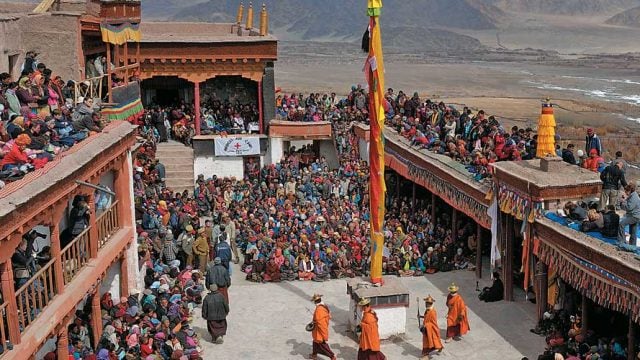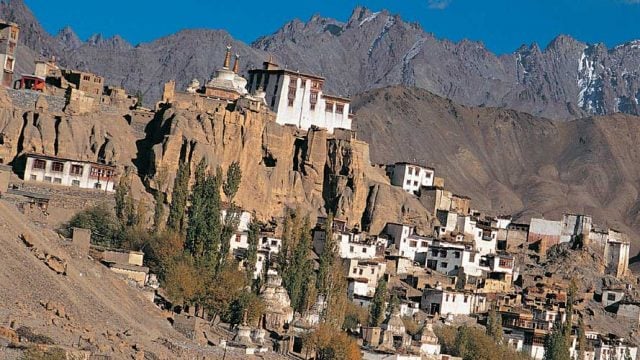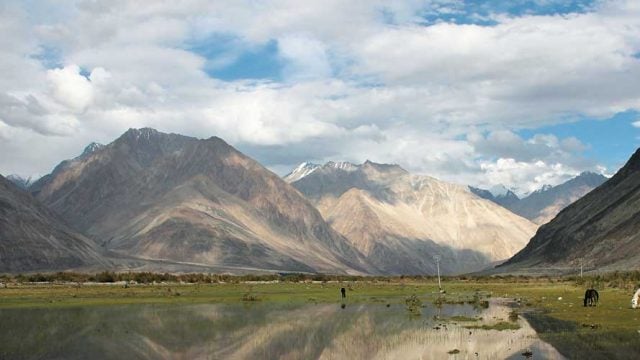Leh is a land like no other. Its snowcapped mountains, translucent lakes, barren landscape and
THINGS TO SEE AND DO
You need at least a week to explore Leh, starting with the gompas. The major ones host festivals on the anniversary of their establishment, the birth anniversary of their patron saint or other important Buddhist dates. Monasteries are open all year round and many celebrate their annual festivals during the winter.

Monasteries
Ladakh is home to some of the most magnificient Buddhist gompas in the world. One of several such monuments erected by a Japanese Buddhist ‘Peace Sect’, Shanti Stupa in Leh (3 km from the main market, above Changspa Village), is decorated with panels depicting the Buddha’s life. The architecture is modern and lacks the character of the other Ladakhi monuments, but the site offers great views of Leh.
Hemis (48 km southeast of Leh), locally known as Tshogkhang, is the wealthiest, grandest and busiest gompa of Ladakh. It was built in 1630 under the patronage of King Singge Namgyal. It has the largest thangka in Ladakh, which is unfurled once in 12 years.
The Thiksey Monastery (19 km southeast of Leh) has a number of stupas, statues and paintings. The main prayer hall has a 15-m high seated Buddha. Shey (14 km southeast of Leh) was once a royal residence, built by the first king of Ladakh. Of religious interest is the palace monastery, which has a 12-ft high copper statue of Maitreya Buddha (the friendly Buddha and the future Buddha) plated with gold. Phyang (17 km north of Leh) was built in the 16th century. It belongs to the Kragyupa Sect and houses statues of the Buddha, thangkas, old manuscripts and old weapons.

The gompa at Spituk (8 km southwest of Leh) commands a panoramic view of the Indus Valley. The monastery, built around the 15th century, has a collection of ancient masks, arms and thangkas. A little beyond the monastery is the Mahakaal Temple dedicated to Vajrabhairava, the most wrathful form of the Bodhisattva Manjushri.
The Likir Monastery (60 km northwest of Leh), also known as Klud-Kyil, was founded in the 11th century (though the present structure dates to the 18th century) and has been part of the Yellow Sect since the 15th century. It contains images of the Buddha and a number of old manuscripts and thangkas.
Built around nine centuries ago, Alchi (68 km west of Leh) is one of the oldest monasteries in the district. One wall here is covered with over a thousand miniature images of the Buddha. Alchi is no longer active and is looked after by the monks of Likir, but it still attracts visitors and there are cafés, tea shops and vendors selling curios.
The oldest of all the monasteries, Lamayuru (120 km west of Leh) was founded in the 10th century. According to legend, there was a large lake at the place where it stands. With the blessing of a lama the water of the lake receded to the mountains to make space for the monastery. Lamayuru has caves carved out of the mountainside and its main hall has several thangkas.

Other Sights
The main bazaar is a great place to soak in the culture of Ladakh. Once the royal capital of the Old Kingdom, Leh town has a number of historical monuments, including the nine-storey palace. Built by King Sengge Namgyal, it is said to have inspired the Potala Palace in Lhasa. The palace and the adjoining ruins of a fort built by King Tashi Namgyal tower over the city. Just ask in the main bazaar for the lane leading to the palace. The palace and fort are quite dilapidated, so be careful while walking around. Near Skara, along the Fort Road, a 20-minute walk from the city centre, is Zorawar Singh’s Fort, built after the Dogra invasion of Ladakh in the late 19th century.
WHERE TO STAY
The top choices here in Leh are Shambhala, Spic-N-Span and Mandala. Shambhala (Cell: 098100-35145; Tariff: ₹5,000-8,000) at Skara, a 25-minute walk from the main town, is quaint, clean and quiet. The well-maintained and centrally heated Spic-N-Span (Tel: 01982-252765; Tariff: ₹7,310-16,280) on Old Leh Road has wraparound balconies with great views. Hotel Mandala (Cell: 09596253464; Tariff: ₹5,200-6,800) on Fort Road is also quiet and has helpful staff.
Padma Guest House and Hotel (Tel: 252630; Tariff: ₹3,500, with two meals) on Fort Road has common bathrooms and is close to the market. Silver Cloud Guest House (Tel: 253128; Tariff: ₹800-4,500) near Sankar Village is basic but clean, as is Rainbow Guest House (Tel: 253061; Tariff: ₹1,500-2,200) in Changspa. The J&K Tourism Tourist Bungalow (Tel: 252297, 252094; Tariff: ₹720- 1,000) at Leh is comfortable, but book in advance.
WHERE TO EAT
One of Leh’s most atmospheric joints is Lala’s Café, in the old town. The Kashmiri food at Budshah Inn, the pizzas at II Forno, the steak with chips at the Leh View Rooftop Restaurant, and the sandwiches at La Terrasse are all excellent. For good Tibetan food, try Amdo Café, Amdo Food, Wok Tibetan Kitchen (Main Bazaar Road), or Devi Tibetan Restaurant (near the State Bank of India). Do not miss the pies and cakes at Pumpernickel German Bakery on Zangsti (Sabzi Mandi) Road or My Secret Recipe. On Fort Road, try the excellent Ladakhi breakfast at Dzomsa, the avocado lassi at Penguin Garden Restaurant and the biryani at Hotel Ibex. Dreamland Restaurant is one of the oldest establishments serving superb Kashmiri, Chinese and Tibetan food, and Summer Harvest excels at Tibetan. Do not miss the Tibetan hot pot at Tibetan Kitchen. Other good places are the open-air Open Hand, Chopsticks Noodle Bar at the Raku Complex and the quirky Gravi T Café. Also try the cheese-and-potato momos at the vegetarian Tenzin Dickey Tibetan Restaurant. At Changspa Road are Café Jeevan, with its excellent terrace, the World Garden Café and Zen Garden, which are popular with backpackers. Bon Appetit is the only fine-dining option in Leh.
When to go June to end-October Location Ladakh’s largest town, Leh lies 10,800 ft above sea level Air Leh Rail Nearest rail: Jammu
|
THE INFORMATION |
|
Tourist Offices Directorate of Tourism (Kashmir) Tel: 0194-2502279 W jktourism.org |
|
JKTDC Tourist Reception Centre TRC Road, Srinagar Tel: 2457927-30 W jktdc.co.in |
|
Director, Tourism Jammu, Tel: 0191-2520409 Leh |
|
Tourist Reception Centre, Leh Tel: 01982-252297, 252094 |
|
Tourist Development Authority Tourist Reception Centre, Leh Tel: 250866 |
|
Permits Deputy Commissioner, Leh Tel: 01982-252010, 252297 STD code 01982, 01985 |
|
Tourist Office, Kargil Tel: 01985-232721, 232266 Zanskar Valley |
|
Tourist Reception Centre, Padum Tel: 01983-245017 STD code 01983 Manasbal |
|
Wular-Manasbal Development Authority Tel: 01954-217541 Cell: 09622912407 |
|
Lolab Bangus Development Authority Cell: 09419017791 STD code 01954 |
|
THE INFORMATION |
|
Tangmarg Tourist Reception Centre Narbal-Tangmarg Road Tangmarg Tel: 01954-254436 STD code 01954 Yusmarg |
|
Yusmarg Development Authority Chief Executive Officer, Yusmarg Tel: 01951-244266 Cell: 09419000272 STD code 01951 Achabal |
|
J&K Tourism Tourist Info Centre, Achabal Cell: 09906606555 Daksum |
|
JKTDC Tourist Bungalow Daksum Cell: 09469515050 Mansar Lake |
|
Tourist Info Counter Jammu Airport. Tel: 0191-2431917 |
|
Tourist Info Counter Jammu Tawi Railway Station Tel: 0191-2476078 |
|
JKTDC Wazwan, Dilli Haat, Opp INA Market New Delhi Tel: 011-24670505 |
|
J&K Tourism TRC, Gulmarg Tel: 01954-254487, 254439 STD Codes Jammu 0191, Delhi 011, Gulmarg 01954 |
Buddhism
culture
Hemis Monastery





